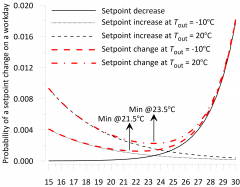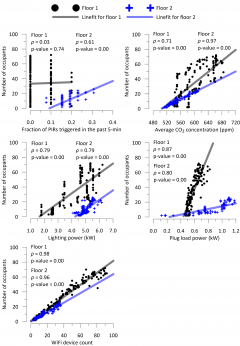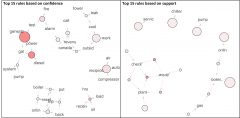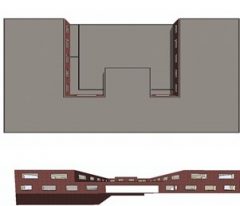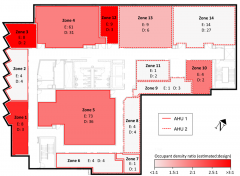Themes
Fault detection, diagnostics, and prognostics in building systems
The objective of this project is to optimize the energy use and occupant comfort in commercial buildings by using sensor, meter, and actuator data gathered in modern building automation and control systems. With this vision in mind, the research project will address four fundamental gaps in the literature: (1) create a dataset comprising common building faults, their symptoms, occurrence frequencies, and impact on energy use and comfort; (2) develop inverse models that explain multiphysical processes and occupant behaviour in buildings from sensor, meter, and actuator data; (3) develop scalable methods to diagnose physical faults in building systems and components; and (4) develop scalable methods to diagnose and correct soft faults in controls programming. The research methods entail field-scale data collection and analyses using existing controls and automation infrastructure of real buildings, field trials, and building performance simulation.
Inverse modelling-based energy performance benchmarking
In this project, we will develop a toolkit that will help operators and energy managers to visualize energy flows within a building and to simulate the energy impact of control decisions. (1) Inverse modelling techniques to establish an energy use baseline will be studied. Energy use anomaly detection algorithms will be formulated. (2) Inverse greybox model-based virtual metering algorithms will be developed to complement existing meter network in a building. These algorithms will help visualize energy flows at greater spatial resolutions than the metering network available.
Data-driven methods for indoor climate control
The objective of this research project is to develop data-driven decision support algorithms that guide better indoor climate control decisions using the data inherent in building automation and control networks. (1) Model-based predictive control methods for system level heating and cooling equipment will be developed and tested. (2) Machine learning-based optimal HVAC start / stop algorithms in high thermal mass buildings. (3) Load forecasting and optimization methods will be developed for plant equipment. (4) Occupant-centric indoor climate control methods will be developed and implemented in real buildings. (4.1) Control algorithms that rely on data-driven occupant behaviour models will be developed for VAV terminal unit control in buildings with mixed-mode ventilation. (4.2) LED lighting automation algorithms that learn from occupants’ illuminance preferences will be developed. Effectiveness of following automation strategies will be systematically assessed: daylight harvesting, dimming, zoning, and vacancy off. Optimal photosensor and motion detector positioning and configuration will be studied. (4.3) Control algorithms that rely on zone-specific occupant thermostat use behaviour patterns will be developed to guide default seasonal zone temperature setpoints.
Occupancy count detection and forecasting in commercial buildings
The most basic requirement for energy efficient building operation is to provide building services only when and where they are needed, in the amount that they are needed. This requirement is inherently linked to various types of occupancy information. The objective of this research project is to develop occupancy-driven operation strategies that will improve energy efficiency and reduce operation costs. (1) Existing occupancy sensing technologies will be reviewed and tested in real buildings. (2) New HVAC occupancy sensor prototypes for large multi-occupant spaces (e.g., auditoriums) will be developed and tested. (3) Sensor fusion models that leverage existing low-cost data streams will be developed and tested for floor level occupancy count estimation. (4) Occupancy forecasting models will be developed and tested. (5) Occupancy-driven operation strategies will be developed, and energy and operation cost savings will be estimated.
Text analytics on operator work order logs
Operators’ work-order descriptions in computerized maintenance management systems (CMMS) offer an untapped opportunity to benchmark a facility’s maintenance and operation performance. However, it is challenging to carry out analytics upon these large and amorphous databases. (1) This project examines text mining and visualization techniques on service request and work order logs to extract high resolution information about failure patterns in building systems and components. (2) A prototype software tool will be developed applying text analytics and visualization techniques to generate action-oriented O&M insights. (3) While developing the software tool, building operators of the partner will be interviewed.
Semantic data models and automatic BAS points mapping
Existing semantic models in building automation systems (BAS) are often inconsistent, non-standard, not well-documented. Thus, conducting data analytics on them is challenging and associated with manual labour. Methods to translate BAS data to a standard data model are needed. This project will develop a suite of functions to facilitate this translation task. (1) Algorithms to parse existing data labels into namespace arguments and conduct lexical analysis will be developed; (2) Classification algorithms to discover data taxonomies from data features will be developed; (3) Clustering algorithms will be examined to discover hierarchical relationships among BAS sensors and actuators.
High resolution LED lighting automation
Unlike conventional coarse lighting zones, PoE LED luminaires that can be controlled individually based on daylight availability and occupancy offer new opportunities to improve visual comfort and energy efficiency. However, highly granular lighting zones also introduce new challenges about calibration, commissioning, and controls. As each luminaire affects the sensors in nearby lighting zones, auto-commissioning algorithms are needed to ensure their coordination. This project employs daylight simulation and field-scale experimentation to develop new auto-commissioning algorithms for their rapid deployment.
Calibrated energy modelling for building retrofits
Calibrated energy models are excellent tools to inform retrofit decisions. The calibration process is challenging because many unknown parameters of a building simulation model such as an EnergyPlus model need to be estimated with monthly or hourly energy use data. The risk of over-parametrization calls the validity of the calibration process into question. The project investigates the uncertainty in the model calibration process, develops recommendations to enhance the reliability of the process in practice, and examines the impact of imperfections in the calibration process on the retrofit decision making process.
Inverse model-based estimation of building envelope health indices
Conventional field-scale envelope testing methods for thermal performance and airtightness have several limitations. Firstly, they require human operators to collect and analyze data from a tightly regulated experiment. Thus, they tend to be labour intensive. Most of them are conducted indoors and can be disruptive for the tenants. Secondly, they can only be employed at certain times of the year under certain circumstances – e.g., fan pressurization tests can only be used at moderate outdoor temperatures and low wind speeds; infrared thermography should be used with minimal solar irradiance, large temperature difference between indoors and outdoors, and at low wind speeds. Thirdly, there are scalability concerns to large commercial and institutional buildings. Therefore, new low-cost non-invasive methods to monitor envelope health indices during the service life of a building are needed to establish envelope performance benchmarks and to direct appropriate resources to address issues related to underperforming building envelopes. In this project, we develop and demonstrate novel inverse model-based approaches for the characterization of envelope thermal transmittance and air permeance with metered heating load and building automation system trend data.
Commercial building ventilation strategies during COVID-19 pandemic
Discrepancies between design assumptions for thermal loads and occupancy levels and reality can have serious implications on how outdoor air is distributed in a building. In the wake of the COVID-19 pandemic, this project investigates these often overlooked assumptions with field data and building performance simulation. The project puts forward short-term occupancy-centric indoor climate control and long-term policy recommendations to reduce the risk of infectious aerosol exposure by eliminating instances of inadequate ventilation.
Collaboration
- Carleton FMP
- ASHRAE MTG.OBB
- IEA EBC Annex 66: Definition and Simulation of Occupant Behavior in Buildings
- IEA EBC Annex 79: Occupant-centric Building Design and Operation (subtask co-leader)
- IBPSA Canada (Board Member)
- ASHRAE TC 7.5 Smart Building Systems
- NRC High Performance Buildings
- NRCan CanmetENERGY Ottawa and Varennes
- CopperTree Analytics
- Bentall Kennedy
- BGIS
- Delta Controls
- Green Power Labs
- Sensible Building Science
- Autodesk
- RWDI
- Rimikon

